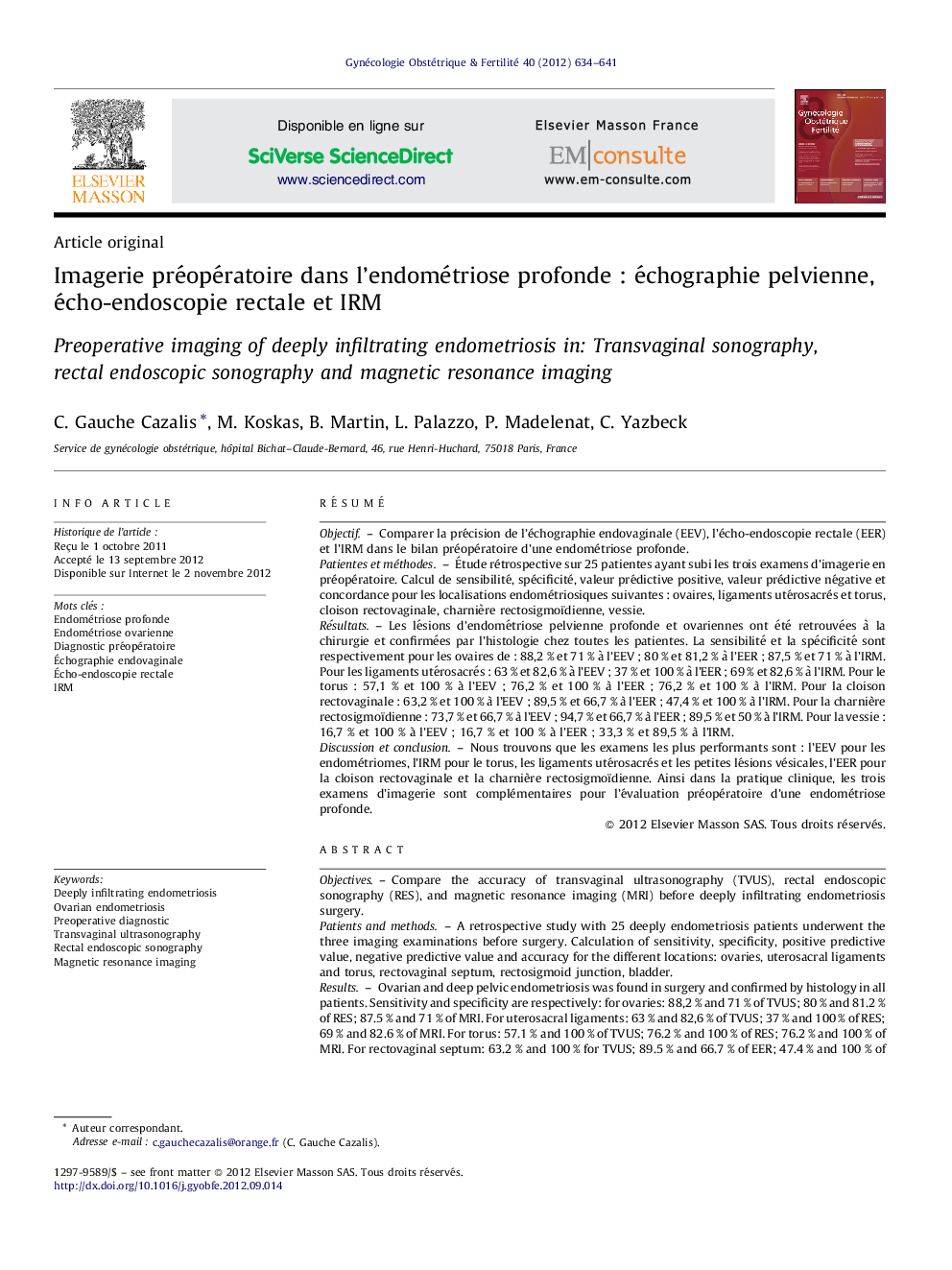| کد مقاله | کد نشریه | سال انتشار | مقاله انگلیسی | نسخه تمام متن |
|---|---|---|---|---|
| 3948475 | 1254644 | 2012 | 8 صفحه PDF | دانلود رایگان |

RésuméObjectifComparer la précision de l’échographie endovaginale (EEV), l’écho-endoscopie rectale (EER) et l’IRM dans le bilan préopératoire d’une endométriose profonde.Patientes et méthodesÉtude rétrospective sur 25 patientes ayant subi les trois examens d’imagerie en préopératoire. Calcul de sensibilité, spécificité, valeur prédictive positive, valeur prédictive négative et concordance pour les localisations endométriosiques suivantes : ovaires, ligaments utérosacrés et torus, cloison rectovaginale, charnière rectosigmoïdienne, vessie.RésultatsLes lésions d’endométriose pelvienne profonde et ovariennes ont été retrouvées à la chirurgie et confirmées par l’histologie chez toutes les patientes. La sensibilité et la spécificité sont respectivement pour les ovaires de : 88,2 % et 71 % à l’EEV ; 80 % et 81,2 % à l’EER ; 87,5 % et 71 % à l’IRM. Pour les ligaments utérosacrés : 63 % et 82,6 % à l’EEV ; 37 % et 100 % à l’EER ; 69 % et 82,6 % à l’IRM. Pour le torus : 57,1 % et 100 % à l’EEV ; 76,2 % et 100 % à l’EER ; 76,2 % et 100 % à l’IRM. Pour la cloison rectovaginale : 63,2 % et 100 % à l’EEV ; 89,5 % et 66,7 % à l’EER ; 47,4 % et 100 % à l’IRM. Pour la charnière rectosigmoïdienne : 73,7 % et 66,7 % à l’EEV ; 94,7 % et 66,7 % à l’EER ; 89,5 % et 50 % à l’IRM. Pour la vessie : 16,7 % et 100 % à l’EEV ; 16,7 % et 100 % à l’EER ; 33,3 % et 89,5 % à l’IRM.Discussion et conclusionNous trouvons que les examens les plus performants sont : l’EEV pour les endométriomes, l’IRM pour le torus, les ligaments utérosacrés et les petites lésions vésicales, l’EER pour la cloison rectovaginale et la charnière rectosigmoïdienne. Ainsi dans la pratique clinique, les trois examens d’imagerie sont complémentaires pour l’évaluation préopératoire d’une endométriose profonde.
ObjectivesCompare the accuracy of transvaginal ultrasonography (TVUS), rectal endoscopic sonography (RES), and magnetic resonance imaging (MRI) before deeply infiltrating endometriosis surgery.Patients and methodsA retrospective study with 25 deeply endometriosis patients underwent the three imaging examinations before surgery. Calculation of sensitivity, specificity, positive predictive value, negative predictive value and accuracy for the different locations: ovaries, uterosacral ligaments and torus, rectovaginal septum, rectosigmoid junction, bladder.ResultsOvarian and deep pelvic endometriosis was found in surgery and confirmed by histology in all patients. Sensitivity and specificity are respectively: for ovaries: 88,2 % and 71 % of TVUS; 80 % and 81.2 % of RES; 87.5 % and 71 % of MRI. For uterosacral ligaments: 63 % and 82,6 % of TVUS; 37 % and 100 % of RES; 69 % and 82.6 % of MRI. For torus: 57.1 % and 100 % of TVUS; 76.2 % and 100 % of RES; 76.2 % and 100 % of MRI. For rectovaginal septum: 63.2 % and 100 % for TVUS; 89.5 % and 66.7 % of EER; 47.4 % and 100 % of MRI. For rectosigmoid junction: 73.7 % and 66.7 % of TVUS; 94.7 % and 66.7 % of RES; 89.5 % and 50 % of MRI. For bladder: 16.7 % and 100 % of TVUS; 16.7 % and 100 % of RES; 33.3 % and 89.5 % of MRI.Discussion and conclusionWe found that TVUS is the more performant for endometriomas, it is MRI for torus, uterosacral ligaments and little bladder lesions, RES for rectovaginal septum and rectosigmoid junction. So in the clinical practice, the three imaging examinations are complementary for the preoperative assessment of deeply endometriosis.
Journal: Gynécologie Obstétrique & Fertilité - Volume 40, Issue 11, November 2012, Pages 634–641